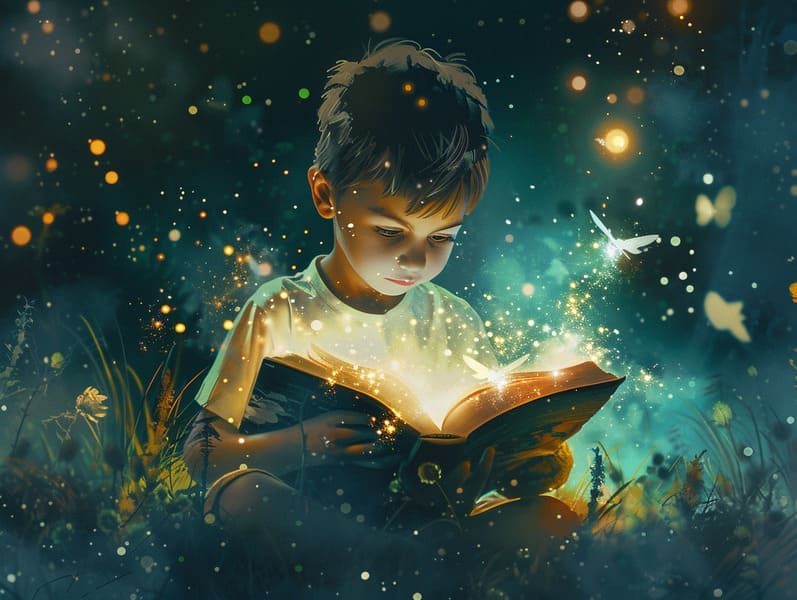
Popular fairy tales have old origins. These tales have been spoken from one generation to the next millennia before they were ever published. They sprang from a variety of backgrounds, including African traditions. They were initially passed along among mature audiences, often carrying themes and messages aligned with the societal norms and beliefs of the time.
Jacob and Wilhelm Grimm, the two Grimm brothers, were among the first to compile many of these beloved fairy tales. Their volume, "Grimm's Folk Tales," included tales like "The Story of Cinderella," "The Bread Crumb Trail," and "Schneewittchen," which have since become classics in the world of classic fairy tales. Similarly, H. C. Andersen's enchanting fairy tales, such as "The Story of the Little Mermaid," and "The Duckling that Could," have captured hearts worldwide, securing their place in the pantheon of timeless fairy tales.
Despite their ancient origins, these tales remain as significant as ever, especially as kids' bedtime tales. These enchanting tales are now available in multiple formats, including colorful picture books, captivating animations, and free fairy tales online.
Their unwavering allure can be linked to several captivating elements:
Ethical Lessons: Traditional fairy tales often illustrate important moral lessons. Fairy tales like "The Shepherd Boy and the Wolf" teach the benefit of truthfulness, while "The Tale of the Tortoise and the Hare" demonstrate the virtues of steadfastness and unassuming nature. These stories offer little ones clear distinctions between moral and immoral, developing their moral compass in a tender yet important way.
Compassion and Knowledge: Old fairy tales frequently showcase characters facing challenges and struggles, stimulating audiences to relate with their struggles and applaud their triumphs. For instance, "The Tale of Beauty and the Beast" highlights the benefit of seeing beyond the surface to recognize the true nature of a person, strengthening perception and understanding.
Cultural Awareness: Many traditional fairy tales are rooted in the cultural contexts from which they emerged. Discovering these tales can provide illuminating insights into different cultures, encouraging a sense of cultural insight and acknowledgment.
Creativity and Fantasy: The enchanted elements in old fairy tales—mythical creatures—invigorate children’s dreaming abilities. These stories lead readers to supernatural realms, kindling inventive dreams and a sense of amazement that lasts a lifetime.
Traditional fairy tales are not only enchanting but also illuminating. They provide fascinating tools in developing various intellectual and emotional capacities in kids. When ancient fairy tales are read aloud, they enhance language proficiency by bringing new language items and complicated sentence structures. This practice also improves hearing abilities and mindfulness, as young ones stay focused, looking forward to see what happens next.
Furthermore, reflecting on the themes and characters of traditional fairy tales can develop problem-solving abilities and thinking skills. Kids are instructed to see patterns, guess what will happen, and grasp cause and effect. These discussions also further little ones articulate their thoughts and feelings, fostering their emotional intelligence.
In today’s technological age, the accessibility of internet fairy tales has made these fairy tales more reachable than ever. Web platforms and applications extend extensive collections of old fairy tales that can be enjoyed or listened through anytime, anywhere. Fairy tales read aloud are particularly widespread, presenting an fun way for young readers to appreciate these alluring stories. Read-aloud books and narrated videos take characters and settings to life, often complemented by delightful audio effects and songs that boost the storytelling experience.
The lasting appeal of traditional fairy tales lies in their ability to change to modern society while keeping hold of their central values. Contemporary versions of these stories often showcase more inclusive characters and modern settings, making them familiar to today’s audience. However, the basic principles of heroism, benevolence, and fair play remain unchanged, continuing to reach listeners of all ages.
Timeless fairy tales also offer a sense of solace and predictability. They feature a well-ordered narrative with a recognizable beginning, middle, and end, often coming to a close with the termination of conflicts and the triumph of morality over wickedness. This predictability can be reassuring for the young, granting a sense of constancy in an ever-changing world.
Classic fairy tales continue to delight and train new generations, maintaining their fascination and impact in modern society. As children's bedtime stories, they deliver up a perfect blend of delight and instruction, aiding moral values, empathy, and creativity. The existence of web-based fairy tales and the well-liked nature of fairy tales read aloud affirm that these timeless tales remain available to new generations.
By conserving and relating these fairy tales, we continue to laud the rich tapestry of creativity and cultural heritage. Whether you are delving into a richly illustrated book, experiencing a cyber library, famous fairy tales for children or listening via an audio story, the allure of bedtime fairy tales is always within reach. These fairy tales show us of the unceasing essence of storytelling and its ability to gather us across generations and cultures.
Regardless if you are accessing a colorful picture book, browsing a digital library, or listening to an read-aloud story, the wonder of timeless fairy tales is always within reach.
These fairy tales illustrate of the unceasing essence of narratives and its ability to tie us across eras and regions, making a tie that delights and instructs alike.